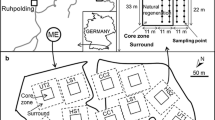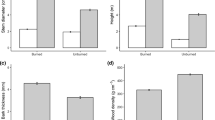Abstract
It is expedient to create plantations of prickly comfrey of multipurpose use (forage, medicinal harvest) in the mountain zone of central North Caucasus. An agrocoenosis of this plant on typical mountain soils is characterized by high aftergrowth, stable productivity, self-renewal, and early spring regrowth. Uniform illumination of the herbage makes it possible to include prickly comfrey in a mixture with other forage grasses.
Similar content being viewed by others
References
Alekseenko, L.N., Produktivnost’ lugovykh rastenii v zavisimosti ot uslovii sredy (Productivity of Meadow Plants Depending on Environmental Conditions), Leningrad: Leningrad Univ., 1967.
Shalym, M.S., Procedure for Studying the Morphology and Ecology of the Underground Part of Individual Plants and Plant Communities, Polevaya Geobotanika (Field Geobotany), Moscow: Akad. Nauk SSSR, 1960, vol. 2, pp. 369–447.
Zaugol’nova, L.B., Evaluation of the Degree of Dynamism of Coenopopulations of Plants within a Single Phytocoenosis, Dinamika tsenopopulatsii rastenii (Dynamics of Plant Coenopopulations), Moscow: Nauka, 1985, pp. 45–62.
Uranov, A.A., Tsenopopulatsii rastenii. Razvitie i vzaimootnosheniya (Plant Coenopopulations. Development and Interrelations), Moscow: Nauka, 1977.
Kayumov, M.K., Spravochnik po programmirovaniyu urozhaev (Handbook on Programming Crop Yields), Moscow: Rossel’khozizdat, 1977.
Metodicheskoe rukovodstvo po issledovaniyu smeshannykh agrofitotsenozov (Guidelines on Methods of Investigating Mixed Agrophytococenoses), Laman, N.A., Samonov, V.P., Prokorova, V.N., et al., Eds., Minsk: Nauka i Teknika, 1996.
Tooming, H.G., Ekologicheskie printsipy maksimal’noi produktivnosti posevov (Ecological Principles of Maximum Crop Productivity), Leningrad: Gidrometeoizdat, 1984.
Fotosintez i bioproduktivnost’: metody opredeleniya (Photosynthesis and Bioproductivity: Methods of Determination), Moscow: Agropromizdat, 1989.
Rukovodstvo po analizam kormov (Forage Analysis Guideline), Derzhavin, L.M. et al., Eds., Moscow: Kolos, 1982, pp. 33–56
Stankov, N.Z., Kornevaya sistema polevykh kul’tur (Root System of Field Crops), Moscow: Kolos, 1964.
Author information
Authors and Affiliations
Additional information
Original Russian Text © A.Ya. Tamakhina, 2008, published in Doklady Rossiiskoi Akademii Sel’skokhozyaistvennykh Nauk, 2008, No. 1, pp. 19–21.
About this article
Cite this article
Tamakhina, A.Y. Biological productivity and stability of a prickly comfrey agrocoenosis in the mountain zone of central North Caucasus. Russ. Agricult. Sci. 34, 21–24 (2008). https://doi.org/10.3103/S1068367408010096
Received:
Published:
Issue Date:
DOI: https://doi.org/10.3103/S1068367408010096




